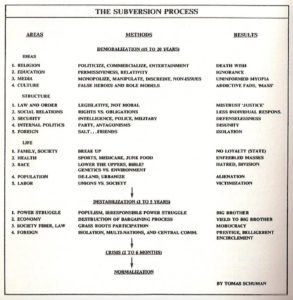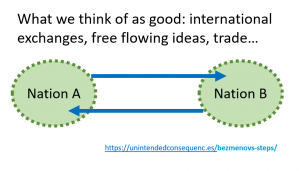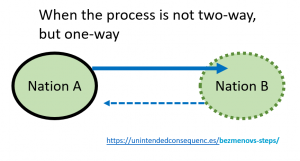“I was engaged in something much more unpleasant than espionage. I was engaged in ideological subversion, which is seldom explained to people by your media, because the media is part of that process.”
That was one of the many quotes that made me take a closer look at some presentations and writings by Yuri Bezmenov (also known as Tomas Schuman) in the mid-1980s.
Bezmenov was a Soviet KGB propaganda agent. After defecting to Canada in 1970, he described the long process of national subversion used by the USSR on international targets. He died in 1993 and it looks like he was forgotten, though over the past decade summaries of his interviews pop up during crises. I (along with others) recently discovered his work and found that his framework for slow national subversion spoke to the modern era (and not just 2020).
I’ve written about disinformation several times in the past (Prester John and the Long History of Disinformation and Disinformation and Disease – Coronavirus Edition). Disinformation and subversion activities that Bezmenov refers to offer an opportunity to appreciate systems on an international scale and how they affect outcomes.
But was Bezmenov just a crank seeking attention? One of his most cited interviews is with someone often described as a conspiracy theorist (at least by Wikipedia) though I don’t believe that people citing that 1984 interview know that. He has been criticized by another ex-KGB spy (Jack Barsky) who questioned whether Bezmenov, a junior operative when he defected, could possibly have known the details he revealed. Or was Bezmenov actually revealing the truth? Whether he revealed an existing ideological subversion operation, or inadvertently provided a blueprint for those who came later, we can learn something from him.
Either way, why did we forget him?
Made Or Just Happened
Earlier disinformation examples I studied seemed more specific and self-contained.
As I wrote in Prester John and the Long History of Disinformation:
“The USSR planted international stories that quoted and spread a pseudo-scientific paper that claimed only a bio-warfare lab could have developed HIV. The pattern used to spread the story was to identify a non-Soviet news source quoting the paper and then amplifying their message. This disinformation may have affected more non-Americans than Americans by convincing them that US-produced condoms and treatments were in fact spreading HIV in their countries.”
That disinformation campaign was, and still is, a factor in AIDS education around the world. That Soviet disinformation campaign, widely cited today, shows what is possible. But was disinformation and subversion really a major source of attention during the Cold War?
Bezmenov says it was. He explains the difference in what we might think subversion is about compared to what it actually is.
“Only about 15% of time, money, and manpower is spent on espionage and such. The other 85% is a slow process which we call either ideological subversion or active measures [meaning] psychological warfare… What it basically means is to change the perception of reality of every American to such an extent that, despite the abundance of information, no one is able to come to sensible conclusions in the interests of defending themselves, their families, their community, and their country.”
To me, the most interesting thing is the simplicity of the framework. Bezmenov lays out a four-step framework for ideological subversion on a national scale, as practiced by the USSR around the world. This is intentional, directional, change that occurs out in the open. The greater openness of some societies makes them susceptible to this process.
- Demoralization. For this step in the process, 15 – 20 years are needed. That is the amount of time required to educate a generation. Helping along the way are media and teachers who have become sympathetic (consciously or unconsciously) to the theoretical causes of the subverting nation. Bezmenov claims that the USSR was surprised at how easy this phase was in the US.
- Destabilization. Following the earlier phase, this is a two to five year period to change the target country’s foreign relations, defense, and economy.
- Crisis. Perhaps six weeks of chaos as a climatic turning point.
- Normalization. This stage changes the appreciation of what the status quo looks like. Bezmenov’s description of this phase also includes military take over.
This is one of his charts of the process in more detail.

According to him, by the time of his mid-1980s interviews, the US was already well past the 20 year mark in the demoralization phase.
“You cannot subvert the Soviet Union,” he explains. American publications may be officially distributed there but they are actually collected and thrown away. The media is controlled. Anyone dissenting is found and silenced.
The view also assumes that the long-term struggle is between open systems that welcome outside influence (and are therefore easy to subvert) and closed systems that block outside influence (and are therefore impossible to subvert).


Why Bezmenov Was Forgotten
Why don’t we commonly learn about Bezmenov or subversion techniques today?
I can guess why a present-day audience couldn’t learn from Bezmenov specifically. He subverted himself. At a couple points during an hour-long talk, his comments on morality include disparaging remarks about gay people. One of his most cited interviews today is with a conspiracy theorist, as I earlier noted. His books look homemade and unprofessional. He advocates for religion as being the best defense against subversion.
Again from one of his presentations:
“The most difficult and at the same time the simplest answer to the subversion, is to start it at the process of demoralization and even before. It’s to bring the society back to religion. Something that you cannot touch, or eat, or put on yourself. Something that rules society… and preserves it.
“Have you ever met a person who would sacrifice his life, freedom for truth [he writes ‘2 + 2 = 4′ on a chalkboard’]. I never met someone who did. But millions sacrifice their life, freedom, comfort for things like God… Something which is not material moves society and helps it to survive. And the other way around. The moment we turn to this [2 + 2 = 4] and make it a guiding principle of our life and existence, we die. Even though this [math] is true and this [religion] you cannot prove.”
These reasons (if they do explain why he was forgotten) for why we don’t study him today strike me as exactly why to study his work, even if only as a thought experiment. Names on lectures, buildings, and medical procedures may change but no one advocates cancelling the lectures, taking down the buildings, or only using medical procedures after vetting an inventor’s beliefs.
The appeal to religion also seems problematic. Marxist-influenced Catholic liberation theology in Latin America gained ground before Bezmenov’s talks and publications. Perhaps religious leaders were subverted as well.
Consider
- With the ability to target individuals on social media, organized state disinformation campaigns gained the ability to try different messaging and experiment at scale. This is the present… and the future for a while.
- Yuri Bezmenov was for putting up a wall to outside influence, not that the current domestic situation is always the best situation. As he said: “I don’t want America to follow the pattern of ancient Japan. You don’t have to shoot every foreigner who approaches the sacred borders of the United States. But when he offers you junk in the guise of a very shiny something, you have to say, ‘no, we have our own junk.'”
- Information control takes different forms, including ban, debauch, block, destroy.
- Calvin: “It says here that ‘religion is the opiate of the masses.’…what do you suppose that means?” Television: “…it means that Karl Marx hadn’t seen anything yet…” (Calvin and Hobbes by Bill Watterson)
*If you liked this post, the next one I recommend is Engineering the Current Thing.
*If you really liked this post, I recommend this book on timing.